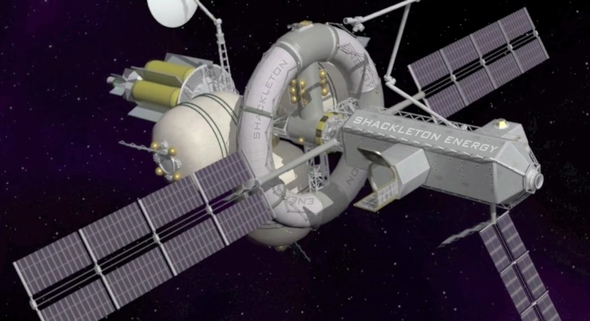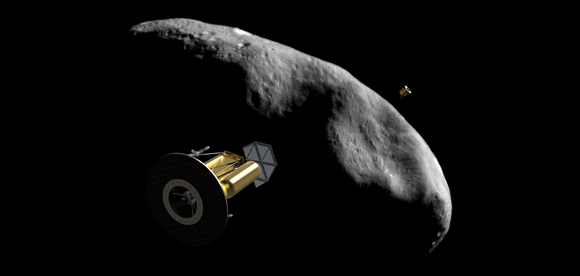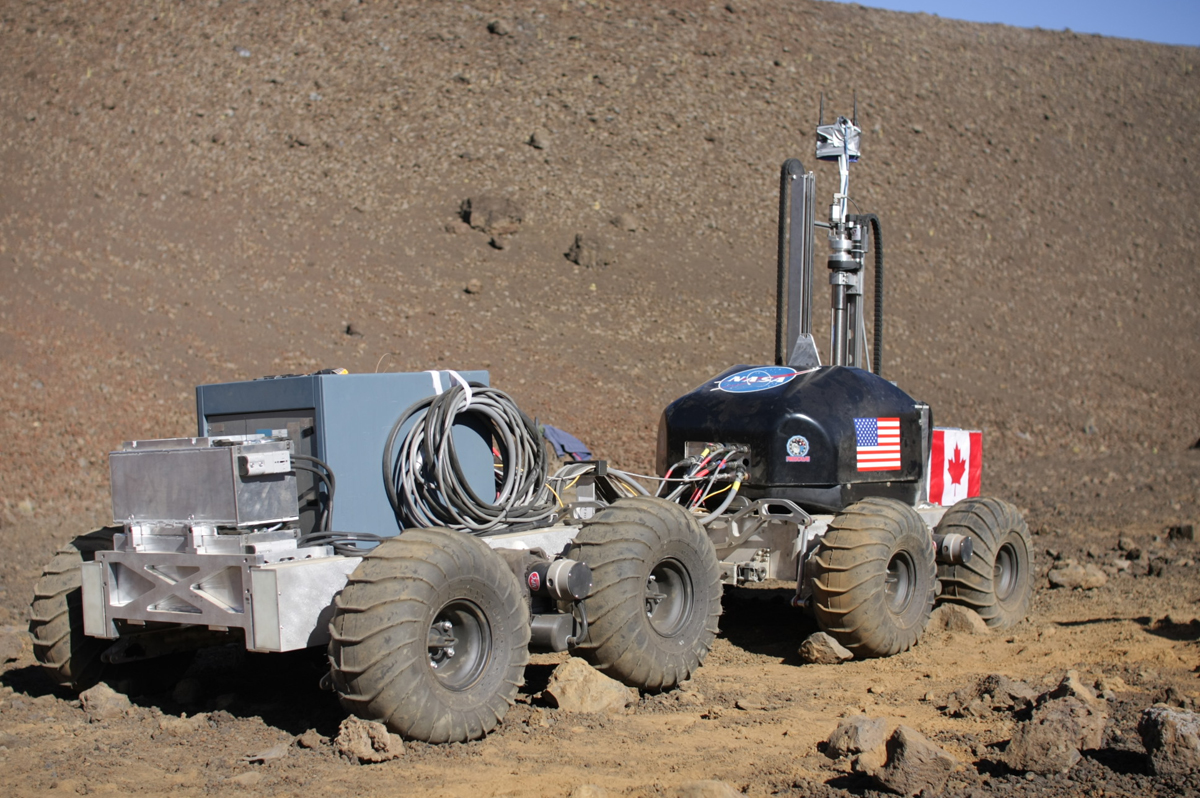
Extraterrestrial Mining Could Reap Riches & Spur Exploration

GOLDEN, Colo. — Mining the plentiful resources of the moon and near-Earth asteroids could alter the course of human history, adding trillions of dollars to the world economy and spurring our species' spread out into the solar system, a new breed of space enterpreneur says.
A number of private companies — such as the billionaire-backed asteroid-mining firm Planetary Resources — aim to start making all of this happen. But it won't be easy, as hitting extraterrestrial paydirt requires melding the know-how of the space and mining communities.
A Space Resources Roundtable meeting was held here June 4-7 to talk about the future of extraterrestrial resource extraction — its promise as well as the challenges involved.
The conference was convened by the Planetary and Terrestrial Mining Sciences Symposium, in collaboration with Colorado School of Mines and the Lunar and Planetary Institute. [Photos: Planetary Resources to Mine Asteroids]
Testing in the field
Establishing a "cis-lunar highway" is on the agenda of Shackleton Energy Co.
By 2020, Shackleton hopes to become the world’s foremost space-based energy company, providing rocket propellant, life support, consumables and services in low Earth-orbit and on the moon to spacefarers. The firm's plan calls for using a mix of astronauts and advanced robotic systems to provide an ongoing and reliable supply of rocket fuel to customers in space.
Get the Space.com Newsletter
Breaking space news, the latest updates on rocket launches, skywatching events and more!
Shackleton wants to establish off-Earth fuel depots, which would allow spaceships to refill their tanks on the go. The company hopes to stock these depots by mining the water ice in permanently shadowed lunar craters. (Water can be broken down into its constituent hydrogen and oxygen, the chief components of rocket fuel.)
"The meeting provided a comprehensive review of the state of the art of space resources analysis and extraction," said Jim Keravala, Shackleton's chief operating officer. "The opportunity for the community to come together, exchange ideas and establish partnerships proved valuable as the time draws near when all these techniques will be tested in the field." [Photos: Searching for Water on the Moon]

Asteroid mining
The April launch of Planetary Resources was beyond the wildest dreams of those who created the group, said Chris Lewicki, the company's president and chief engineer. Public and investment interest in the firm has been overwhelming since its official unveiling, he said.
The company counts several billionaires among its backers, including Google moguls Larry Page and Eric Schmidt. Filmmaker and adventurer James Cameron is one of a number of high-profile Planetary Resources advisers.
The technology now exists to access resources from near-Earth asteroids, and Planetary Resources' mission is to make that happen, Lewicki said.
"It’s a shooting gallery out there…and there’s a lot out there in our favor," Lewicki told roundtable attendees. "Yes, we’re the asteroid mining company, but it’s a lot more than that."
Planetary Resources hopes its mining activities help spur a broader space economy, one in which many different companies are involved in space tourism, space-based solar power and off-planet resource extraction, Lewicki said.
The central, long-term aim of Planetary Resources, Lewicki said, is "taking the economic sphere of influence of all of us and moving it beyond the geostationary belt…which is where it currently, abruptly stops."

Tipping point?
All of this could happen sooner than many people think.
"We may be teetering on the brink of a tipping point," said Leslie Gertsch, deputy director of the Rock Mechanics & Explosives Research Center at the Missouri University of Science and Technology.
"Whether it’s truly a speedup, after decades of frustrated dreaming, or just a bump in the upward climb, the next five to 10 years will tell," she told SPACE.com.
Gertsch said that companies like Shackleton and Planetary Resources will "either grow to become actual resource producers…or fade into wannabe oblivion."
She noted that such groups appear to be planning more carefully than many have done previously, with much of the hand-waving replaced by viable business plans and systematic prospecting ideas.
Still, there’s more work to do. For instance, what’s the true value of a hefty asteroid — say, one 1,650 feet (500 meters) wide? At the moment, it's tough to say. It depends on the asteroid’s composition throughout, not just on its surface, Gertsch said.
"That sort of detail isn’t mundane … it’s utterly crucial," Gertsch added. No mining company can succeed unless it understands what is available. That is, where are the deposits, and which ones are extractable? What can they sell and what are the markets?
"At last serious groups of smart people are focusing on getting down to business for real," Gertsch said.

Investor-friendly environment
The roundtable produced a number of take-home messages, said Rob Mueller, a senior technologist in the Surface Systems Office at NASA's Kennedy Space Center in Florida.
One of these is the need for a clarified legal situation, so there's no question about who owns resources extracted from asteroids or other celestial bodies.
"There is a shift in the space resources community towards more private industry involvement with a heavy emphasis on profit incentives," Mueller said. "The private companies need a legal framework that allows them to operate in an investor-friendly environment to minimize the legislative risk."
In this regard, Mueller said, a good analogy would be the early days of Alaskan mining when the legal framework was not clear, since Alaska had just been purchased from Russia and was not a state as yet. California had the same problem, he said.
Another message is the need to send out some bona fide prospecting probes to get things going.
"The next logical step is to land on the moon with a prospecting mission to confirm the presence of water, locate it and characterize its physical state," Mueller told SPACE.com.
Mueller mentioned the Regolith and Environment Science and Oxygen and Lunar Volatile Extraction, or RESOLVE, hardware, built to prospect for water and other volatiles on the moon’s surface. RESOLVE is a joint project of NASA and the Canadian Space Agency.
"It is looking for a ride, and a prototype is being tested on Mauna Kea in Hawaii this July," Mueller said.
NASA can’t afford not to invest in in-situ resource utilization, Mueller emphasized, since its goal is to land humans on Mars and the space agency’s Design Reference Architecture relies on in-situ resource utilization to make it feasible.
"ISRU could also open up a new economic sphere of influence, which could be strategically important in the future," Mueller concluded. [Future Visions of Human Spaceflight]
Control-Alt-Delete
Kurt Sacksteder, chief of the Space Environment and Experiments Branch at NASA’s Glenn Research Center in Ohio, asked an intriguing question at the roundtable: Inserting space resources into the future of space exploration — do we need Control-Alt-Delete?
"It seems increasingly likely that the resources for fully implementing exploration visions will never be provided at a rate sufficient to make progress," Sacksteder said. "Existing NASA exploration architectures may never be funded for realization as envisioned."
Another key question is whether — and how — the emergence of serious private investment changes the role of government in space, Sacksteder said.
"Aggressive, well-financed private investment may be enabled by re-directed government attention to high-risk technology development and carefully designed space infrastructure," Sacksteder said. "Such a paradigm shift will need a lot of work to teach its value."
'A whole different game'
The Space Resources Roundtable has been meeting for more than a decade, but this year's gathering was different, attendees said.
"This is the first time that we see a larger contingency of the private sector coming here," said Angel Abbud-Madrid, director of the Center for Space Resources at the Colorado School of Mines here in Golden.
"It used to be that we would get all the NASA people discussing what the plans are and how we can contribute to that. But now it’s a whole different game….now it’s how can we get the private sector involved in all of this that we’ve been talking about for so long," Abbud-Madrid said.
Also, getting the government to appreciate the role that the private sector can play is key, Abbud-Madrid said. "I think that more and more, they are going to be taken more seriously…and that helps both sides."
Leonard David has been reporting on the space industry for more than five decades. He is a winner of last year's National Space Club Press Award and a past editor-in-chief of the National Space Society's Ad Astra and Space World magazines. He has written for SPACE.com since 1999.
Join our Space Forums to keep talking space on the latest missions, night sky and more! And if you have a news tip, correction or comment, let us know at: community@space.com.

Leonard David is an award-winning space journalist who has been reporting on space activities for more than 50 years. Currently writing as Space.com's Space Insider Columnist among his other projects, Leonard has authored numerous books on space exploration, Mars missions and more, with his latest being "Moon Rush: The New Space Race" published in 2019 by National Geographic. He also wrote "Mars: Our Future on the Red Planet" released in 2016 by National Geographic. Leonard has served as a correspondent for SpaceNews, Scientific American and Aerospace America for the AIAA. He has received many awards, including the first Ordway Award for Sustained Excellence in Spaceflight History in 2015 at the AAS Wernher von Braun Memorial Symposium. You can find out Leonard's latest project at his website and on Twitter.









